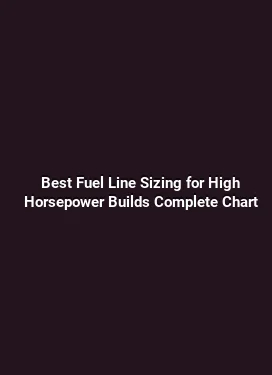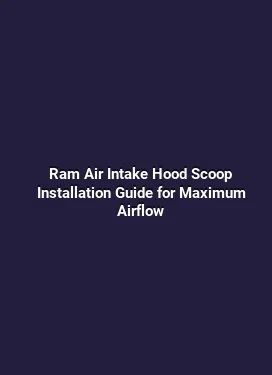Throttle Body Spacer: Myth or Real Performance Gains? Dyno Tested
Throttle body spacers have long lived at the intersection of curiosity and practical modding in many vehicles. This piece dives into the engineering rationale, the range of potential gains, and what actually shows up on a dyno when a spacer is added to an intake system with fuel management being the backbone of performance. The goal is to present clear, test-backed information that helps enthusiasts make informed decisions about installation, effectiveness, and application contexts.
What a Throttle Body Spacer Is and How It Works

A throttle body spacer is a machined ring or block placed between the throttle body and the intake manifold, sometimes with its own air passages or grooves. The central idea is to modify the path of incoming air in a way that can promote swirl or alter velocity at specific RPM ranges. The effect is highly dependent on the paired components: the design of the spacer, the diameter and bore of the throttle body, and the overall intake tract length.
From a fluid dynamics perspective, a spacer can influence air velocity, pressure distribution, and boundary layer behavior as air enters the intake manifold. In practice, the most common claims relate to improved throttle response, a small bump in mid-range torque, and a smoother airflow profile at high RPM. However, the magnitude of any observed change is highly sensitive to engine speed, vehicle weight, gearing, and how the engine management system reacts to the altered sensor signals.
Spacer Designs and Their Practical Impacts

Spacer designs vary. Some are simple shims that sit in the gap between the throttle body and intake plenum, while others include internal passages, ridges, or channels intended to create controlled vortex structures. The practical impact hinges on how the modified air entering the manifold mixes with fuel and how the intake air temperature changes as air travels through the spacer. Theoretical advantages include a more uniform air-fuel mixture and reduced throttling losses at certain loads, but there is no universal rule that a spacer will deliver a substantial improvement in all setups.
When evaluating a spacer, consider the engine’s fuel system, displacement, and cam timing. A naturally aspirated four-cylinder with a relatively simple intake path may respond differently from a turbocharged V6 with a complex air route. In some cases, the spacer’s influence on air velocity interacts with the mass air flow sensor signal in subtle ways, which the ECU will compensate for. This compensation can mask, exaggerate, or distort the perceived gains during a dyno session depending on test methodology and ambient conditions.
Dyno Testing: What Actually Gains When a Spacer Is Installed
Dyno tests aim to quantify power and torque changes with controlled variables. When a spacer is installed, the results often show small, localized gains rather than dramatic horsepower jumps. The most consistent observations tend to surface in mid-range torque curves and throttle response, especially in engines that are operating near the intake’s resonant frequencies or where the intake tract length interacts with the cam profile.
In practice, dyno data collected across a handful of vehicles with similar intake configurations indicate gains rarely exceed a few horsepower at peak and sometimes are within the noise threshold of the test. More telling are improvements in volumetric efficiency at certain RPM bands and a more stable torque delivery as the throttle plate opens under load. It is important to acknowledge that a spacer’s effect is not guaranteed and varies with exhaust routing, intake manifold design, and fuel system calibration.
Interpreting Dyno Data: Realistic Expectations
When reviewing dyno charts, look for shifts in the mid-range power band rather than dramatic spikes at peak torque. A spacer that moves the torque curve upward by 3–8 lb-ft in the 3000–5000 RPM window can feel noticeable in everyday driving, especially in urban or sport driving where mid-range pull matters. Conversely, if a dyno run shows only a marginal increase or even a dip in certain RPM ranges, the spacer may not be optimizing the air-path for that specific engine and calibration combination.
Calibration and fueling strategy play a critical role. A spacer changes the air mass entering the cylinders, which can alter the air-fuel ratio unless the fuel delivery or ECU tuning is adjusted accordingly. For engines running stock fueling with a modest ignition timing map, even small air-path alterations may require no more than a re-tune or conservative ECU adaptation to maintain air-fuel balance and avoid knock or misfire risks.
Installation Context: When a Spacer Makes Sense
There are several scenarios where a throttle body spacer might be worth exploring. For high-revving engines with long intake runners, a spacer can interact with the resonant lengths of the intake system to influence the pressure waves that travel through the intake tract. In boosted or turbocharged applications, the interaction with turbo compressor surge and post-throttle plenum dynamics can be more complex, so gains may be inconsistent and highly engine-specific.
Install considerations include the spacer’s material (aluminum vs. polymer composites), tolerances, and how it seals against the throttle body and intake manifold. A poorly sealed spacer can introduce vacuum leaks, which will cause erratic idle or lean conditions. The alignment of mounting hardware, gaskets, and the potential need for retorquing during the first heat cycle are practical realities that affect reliability and performance outcomes.
Fuel System and Engine Management Interplay
The fuel system must be capable of maintaining an accurate air-fuel ratio with any change in air flow. In modern engines, the ECU uses mass air flow data, throttle position, and manifold pressure to adjust fueling. A spacer alters the air flow pattern, which can influence volumetric efficiency and transient air delivery. In some systems, short-term fuel trim can adjust quickly enough to maintain stoichiometry, while in others the adjustment may lag, leading to transient enrichments or lean conditions if calibration isn’t revisited after installation.
For enthusiasts considering a spacer, a practical approach is to pair testing with a conservative retune window. After installation, monitor long-term fuel trims and ongoing idle behavior. If the vehicle exhibits misfires or hesitation, reassess the spacer choice, check for vacuum leaks, and consider a light calibration update to harmonize the air-path with the engine’s fueling strategy.
Practical Guidance: How to Choose, Test, and Validate
Choosing a spacer should involve evaluating the specific engine, its induction system, and the goals of the modification. If the aim is to improve low-to-mid range response for daily driving, a spacer designed to promote gentle swirl without introducing excessive pressure drop can be a reasonable option. For track-oriented builds that push toward peak power, conduct a cautious assessment, since the gains may be small and not reliably repeatable across sessions.
Testing methodology matters. Use identical dynamometer conditions, ambient temperatures, and vehicle setups when comparing baseline runs to post-installation runs. Ensure the test protocol captures repeatable pulls across a defined RPM range. Consistency in gear selection, load, and cooling conditions minimizes variability and helps isolate the spacer’s effect from other variables such as clutch slip or drivetrain losses.
Best Practices for Installation
Before installing a spacer, inspect the throttle body and intake manifold mating surfaces for cleanliness and damage. Use a high-quality gasket and a torque sequence that matches the manufacturer’s specifications. After installation, perform a short heat cycle to allow any new seals to seat, then verify vacuum integrity with a smoke test or similar diagnostic method. A careful torque check after the first heat cycle is advisable to ensure nothing has shifted under temperature changes.
Document baseline readings: fuel trims, idle stability, and throttle response. Post-installation, recheck these metrics and log any changes. If a spacer brings perceptible changes in driveability without compromising idle quality, it can be a sign of a well-matched combination. If, however, the vehicle exhibits rough idle, surge, or misfires under light throttle, reconsider the spacer’s compatibility with the current intake geometry and calibration.
Contextual Considerations: Urban Driving, Road Course, and Everyday Use
For daily drivers, the perceived gains from a throttle body spacer may be subtle. The most valuable takeaway often lies in the qualitative feel: quicker throttle response in mid-range, smoother transitions when shifting, and a more linear progression of power as the accelerator is applied. For enthusiasts who frequently drive in stop-and-go traffic or enjoy spirited back-road driving, a spacer may contribute to a more approachable mid-range torque delivery that enhances perceived performance without demanding significant fuel economy trade-offs.
On a road course or in competitive scenarios, the interaction with other performance components—such as exhaust manifolds, intake runners, and calibration strategies—becomes critical. The spacer is not a panacea; it is one element in a broader optimization strategy that includes proper cam timing, intake tuning, and fuel strategy. When integrated thoughtfully, it can complement other modifications that aim to broaden the usable torque band and improve throttle responsiveness under load.
Maintenance and Longevity Considerations
Maintenance implications are generally straightforward. A spacer itself does not wear on moving parts, but attention to gaskets and mounting hardware is essential. Over time, gasket surfaces may degrade or settle, potentially altering seals and boosting the risk of vacuum leaks. Regular inspection during service intervals is prudent, especially after the first few heat cycles post-installation. Cleanliness remains important; any debris in the throttle body or intake path can negate the intended benefits and contribute to rough running.
Ultimately, the decision to use a throttle body spacer should be guided by measured data and real-world feedback from your specific vehicle. While it is possible to observe meaningful improvements in certain configurations, it is equally plausible to find negligible gains in others. A structured testing approach, combined with prudent calibration, is the best path to a reliable conclusion about performance gains.
Bottom-Line Insights: How to Approach This Modification
Approaching a throttle body spacer as part of an intake and fuel system upgrade means balancing anticipated, test-backed gains with the realities of engine calibration and system-wide interactions. For most engines, a spacer can contribute to modest mid-range improvements and a refined throttle feel, provided the installation is executed correctly, the seals are reliable, and fueling is appropriately tuned. In engines with complex air paths or aggressive boost, the outcomes may vary widely and should be validated with careful dyno testing and on-road validation.
In the end, the spacer is best viewed as a potential assistive component within a holistic approach to intake efficiency and fuel management. When used judiciously, it can help refine airflow characteristics and contribute to a smoother, more connected driving experience without introducing reliability concerns. The key is to establish a baseline, perform controlled tests, and interpret results through the lens of the broader engine tuning and vehicle behavior.






